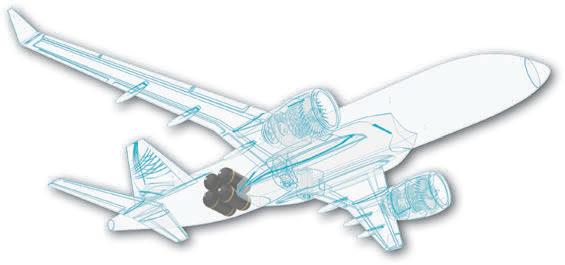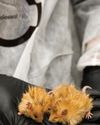Intentar ORO - Gratis
TAKING OFF TOWARD A GREENER FUTURE
Muse Science Magazine for Kids
|November/December 2023
Efforts to make flying sustainable

Flying may be the quickest way to travel long distances, but it also releases a lot of carbon dioxide (CO2) and other harmful emissions into the air. This worsens global warming and the problems wrought by climate change. Concern about air travel’s carbon footprint has led some environmental advocates to ditch flying altogether. ut is this the only solution? Researchers are exploring ways to create a greener future for aviation.

First Steps
On January 19, 2023, a small, 19-seat twin-engine aircraft took to the skies. It completed a 10-mile (16-km) loop before returning to Cotswold Airport in the United Kingdom. This aircraft is the world's largest to complete a flight powered by hydrogen fuel-a clean energy source with zero carbon emissions.

Under its left wing, two fuel cells work in harmony. Fuel cells act a bit like batteries. These convert hydrogen into electricity to power an electric motor. A lithium battery provides an additional boost of energy during takeoff. As a safety measure, a standard plane engine drives the other propeller.
This successful test flight is a huge step toward making air travel more environmentally friendly. But researchers aren't stopping here. Now, their focus is on larger aircraft and on fueling 40- to 80-seater planes with hydrogen. This will be no simple feat, but it appears key to making zero-carbon flight a reality.

Reality Check
Esta historia es de la edición November/December 2023 de Muse Science Magazine for Kids.
Suscríbete a Magzter GOLD para acceder a miles de historias premium seleccionadas y a más de 9000 revistas y periódicos.
¿Ya eres suscriptor? Iniciar sesión
MÁS HISTORIAS DE Muse Science Magazine for Kids

Muse Science Magazine for Kids
ANIMAL FIREFIGHTER TO THE RESCUE
Can animals help manage the risks of deadly wildfires?
3 mins
Muse July 2025: The Story Behind Wildfires

Muse Science Magazine for Kids
FIRE DANGER
WHY THE RISK OF WILDFIRES KEEPS GROWING
4 mins
Muse July 2025: The Story Behind Wildfires

Muse Science Magazine for Kids
The Miller NEW Normal
WHAT TODAY’S WILDFIRES TELL US ABOUT OUR FUTURE
8 mins
Muse July 2025: The Story Behind Wildfires

Muse Science Magazine for Kids
WOMEN AND FIREFIGHTING: A GOOD FIT
Jessica Gardetto is a firefighter. Her father was, too. “I grew up with my dad coming home smelling like wildfire and covered in soot,” she says.
1 min
Muse July 2025: The Story Behind Wildfires

Muse Science Magazine for Kids
What is happening on your fingertips when they get all wrinkly in a hot tub?
—Felix G., age 10, Montana
1 mins
Muse July 2025: The Story Behind Wildfires

Muse Science Magazine for Kids
WHEN the SMOKE CLEARS
THE LINGERING EFFECTS OF THE RECENT PACIFIC PALISADES AND ALTADENA EATON FIRES
6 mins
Muse July 2025: The Story Behind Wildfires

Muse Science Magazine for Kids
PICKING TEAMS
Keep it fair with a strategy that relies on geometry.
2 mins
Muse July 2025: The Story Behind Wildfires

Muse Science Magazine for Kids
SHAN CAMMACK
WILDLIFE BIOLOGIST AND FIRE SAFETY OFFICER
3 mins
Muse July 2025: The Story Behind Wildfires

Muse Science Magazine for Kids
Scientists Create Mice With Woolly Mammoth-Like Fur
RESEARCHERS AT A COMPANY IN TEXAS ARE WORKING TO CREATE A LIVING ANIMAL THAT RESEMBLES THE EXTINCT WOOLLY MAMMOTH. Recently, they produced mice with traits of the large mammal. The mice all have coats with mammoth-like fur, and some of the small mammals also have genes that help them store fat. Both features would help the animals survive in the cold Arctic, where the woolly mammoth once lived.
1 min
Muse July 2025: The Story Behind Wildfires

Muse Science Magazine for Kids
Cool Sunshade Added to the Nancy Roman Space Telescope
THE NANCY ROMAN SPACE TELESCOPE IS A NEW TELESCOPE THAT NASA IS BUILDING AND WILL LAUNCH INTO SPACE, LIKELY IN EARLY 2027.
1 min
Muse July 2025: The Story Behind Wildfires
Translate
Change font size

